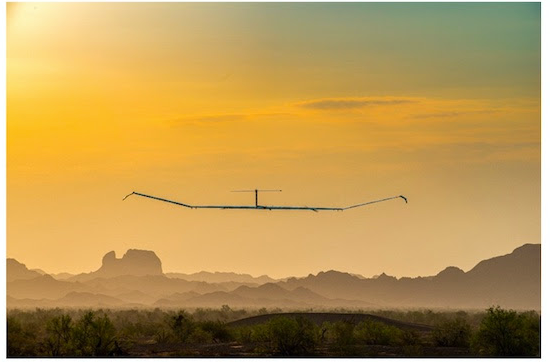Japanese operator NTT DoCoMo and aerospace company Airbus have successfully tested a solar-powered stratospheric drone, using it to deliver a data link at a distance of up to 140 kilometers (about 87 miles).
The U.S.-based trial took place in August, when Airbus’ Zephyr S aircraft performed approximately 18 days of stratospheric flights in order to capture data about link performance at different altitudes, at different times of day and night, and under clear, cloudy or rainy weather conditions. The tests involved the HAPS providing a link to a ground antenna, simulating direct-to-device service from the HAPS to end users at low, “nominal” and high throughput rates.
While the HAPS generally flew at a height of about 20 km (12.4 miles), NTT DoCoMo and Airbus said that data transmissions were achieved at a range of up to 140 km.
The two companies said that the demonstration “confirmed the viability and versatility of the 2 GHz spectrum for HAPS-based services and also the use of a narrow (450 MHz) band to provide connectivity … . … Based on the results of this experiment, Airbus and NTT DoCoMo aim to provide communication services to mountainous areas, remote islands, and maritime areas.”
“DOCOMO believes that HAPS will be a promising solution for coverage expansion in 5G evolution and 6G,” said Takehiro Nakamura, GM of NTT DoCoMo’s 6G-IOWN Promotion Department. “In this measurement experiment, we were able to demonstrate the effectiveness of HAPS, especially for direct communication to smartphones, through long-term propagation measurements using actual HAPS equipment. Based on these results, we would like to further study the practical application of HAPS in 5G evolution and 6G with Airbus.”
Non-terrestrial networks (NTN), such as satellite systems and HAPS, are expected to play an increasingly important role as 5G evolves and in not-yet-standardized, future 6G systems. HAPS and NTNT offer a way to extend coverage in remote areas, across oceans and at aircraft-height, where traditional terrestrial systems have a difficult time reaching; and can be useful for disaster response communications or augmenting terrestrial coverage.
“Billions of people across the world suffer from poor or no connectivity. These tests show us the viability of the stratosphere to bridge this divide and provide direct to device connectivity via Zephyr without the need for base stations or extra infrastructure,” Stephane Ginoux, SVP and head of the North Asia region for Airbus, and president of Airbus Japan.
The two companies said that data from the testing will be used to support future LTE services provided by Airbus’ Zephyr.

